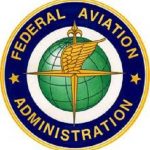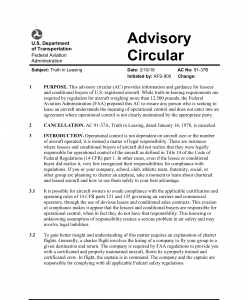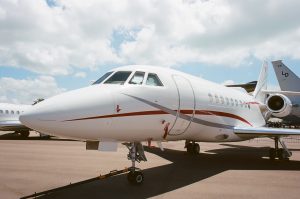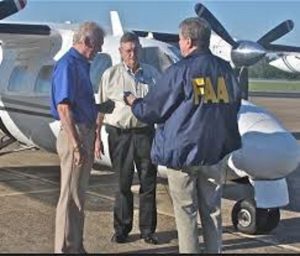From the FAA’s perspective, operational control in aircraft leasing transactions is not just a “big deal”, it is “the” deal.
What Is Operational Control?
 14 C.F.R §1.1 defines operational control as “the exercise of authority over initiating, conducting or terminating a flight.” In a “wet” lease situation, since the lessor is providing both aircraft and crew, the lessor maintains operational control of all flights. And in the absence of a specific exemption (such as under 14 C.F.R. § 91.501(c) the lessor who is operating an aircraft under a wet lease will need to have an air carrier certificate to legally operate the aircraft.
14 C.F.R §1.1 defines operational control as “the exercise of authority over initiating, conducting or terminating a flight.” In a “wet” lease situation, since the lessor is providing both aircraft and crew, the lessor maintains operational control of all flights. And in the absence of a specific exemption (such as under 14 C.F.R. § 91.501(c) the lessor who is operating an aircraft under a wet lease will need to have an air carrier certificate to legally operate the aircraft.
In a “dry” lease situation, the lessee provides its own flight crew, and the lessee exercises operational control over its flights. The lessee’s operations may be conducted legally under 14 C.F.R. Part 91 without an air carrier certificate.
It is important to keep in mind that the FAA will look beyond the actual written agreements to determine who has operational control. Although a lease may be written as a dry lease and says “Dry Lease” at the top of the agreement, for example, that does not mean the FAA cannot take the position that the arrangement is really being conducted as a wet lease. And if the FAA takes that position when the lessor who is actually operating the aircraft for the lessee does not have an air carrier certificate, then that will be a problem for the lessor, and potentially for the lessee as well.
Why Does It Matter?
If the lessor is exercising operational control, then the flight must be conducted in compliance with regulations that are stricter than Part 91 (i.e. Parts 121 or 135). Those regulations limit the types of airports the lessor may utilize, crew qualifications, crew rest and duty times, maintenance requirements etc. Additionally, the lessor under a wet lease arrangement is required to remit federal excise tax on the amount charged to the lessee.
Alternatively, if the lessee has operational control under a dry lease the lessee is permitted to operate under the less restrictive and less costly requirements of Part 91. And federal excise tax is not due on the amounts paid by the lessee to the lessor, although sales tax is often assessed on the lease rate.
How Do You Determine Who Has Operational Control?
 The FAA has issued guidance for determining which party has operational control in a leasing arrangement. Advisory Circular 91.37B Truth in Leasing provides FAA inspectors with an explanation of leasing structures and how they may or may not be compliant with the regulations. Although AC 91.37B only applies to aircraft subject to the requirements of 14 C.F.R. § 91.23, and it is not regulatory in nature, FAA inspectors also use this guidance when reviewing leasing structures that are not subject to truth-in-leasing requirements.
The FAA has issued guidance for determining which party has operational control in a leasing arrangement. Advisory Circular 91.37B Truth in Leasing provides FAA inspectors with an explanation of leasing structures and how they may or may not be compliant with the regulations. Although AC 91.37B only applies to aircraft subject to the requirements of 14 C.F.R. § 91.23, and it is not regulatory in nature, FAA inspectors also use this guidance when reviewing leasing structures that are not subject to truth-in-leasing requirements.
Here are the types of questions an FAA inspector will ask when the inspector is trying to determine which party has operational control in an aircraft leasing situation:
-
Who decides crewmember and aircraft assignments?
-
Who accept flight requests?
-
Who actually initiates, conducts, and terminates flights?
-
Are the pilots direct employees or agents for the lessor, the lessee, or someone else?
-
Who is responsible for aircraft maintenance and where is that maintenance performed?
-
Who decides when/where maintenance is accomplished, and who pays the maintenance provider for that service?
-
Prior to departure, who ensures the flight, aircraft, and crew comply with regulations?
-
Who determines weather/fuel requirements, and who pays for the fuel at the pump?
-
Who directly pays for the airport fees, parking/hangar costs, food service, and/or rental cars?


 For example, if the aircraft is leased to more than one lessee, it may make more sense for the lessor to retain responsibility for maintenance to ensure that the aircraft is consistently maintained in an airworthy condition. Similarly, lessor maintaining an insurance policy insuring the aircraft and the various lessees may be necessary to make certain the aircraft is insured appropriately.
For example, if the aircraft is leased to more than one lessee, it may make more sense for the lessor to retain responsibility for maintenance to ensure that the aircraft is consistently maintained in an airworthy condition. Similarly, lessor maintaining an insurance policy insuring the aircraft and the various lessees may be necessary to make certain the aircraft is insured appropriately. The key indicia in the language above is lessor’s providing the flightcrew. However, lessor’s responsibility for maintenance by itself does not indicate that lessor is improperly exercising operational control over lessee flights. Although it may indicate that lessor is exercising some operational control, without other indicia of operational control by the lessor, performance of maintenance alone is not conclusive.
The key indicia in the language above is lessor’s providing the flightcrew. However, lessor’s responsibility for maintenance by itself does not indicate that lessor is improperly exercising operational control over lessee flights. Although it may indicate that lessor is exercising some operational control, without other indicia of operational control by the lessor, performance of maintenance alone is not conclusive.